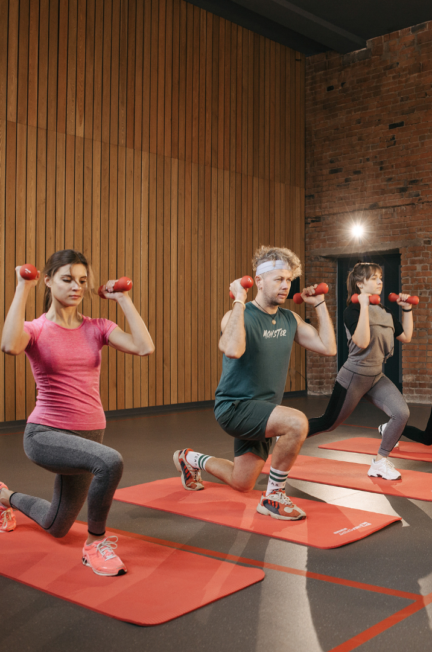Are you tired of hearing conflicting advice about exercise and fitness? Do you ever feel overwhelmed by the sheer amount of information out there, wondering what’s true and what’s just another myth? Well, it’s time to set the record straight! In this blog post, we’re going to debunk some of the most common myths about exercise and fitness. Whether you’re a beginner or a seasoned pro, these misconceptions can hold you back from reaching your full potential. So get ready to learn the truth about working out and discover how to achieve your goals with confidence!
Overview Of Exercise And Fitness
The benefits of exercise and physical activity are well-known. Regular exercise can help you control your weight, reduce your risk of heart disease and stroke, improve your mental health and mood, and increase your energy level. Despite these well-known benefits, there are still many myths about exercise and fitness.
One common myth is that you have to be fit to start exercising. This is simply not true! You can start slowly and gradually increase the intensity and duration of your workouts as you get more comfortable with the exercise. Another myth is that you need expensive equipment or a gym membership to get started. Again, this is not true! There are plenty of ways to get active without spending a lot of money. Walking, jogging, swimming, and biking are all great exercises that can be done for free or for very little cost.
Another myth is that exercising is only for people who want to lose weight. While exercise can help you lose weight, it’s also important for people who want to maintain their weight. Exercise helps to keep your metabolism up and prevents your body from storing excess fat. Finally, some people believe that they don’t have time to exercise. However, even just 30 minutes of moderate-intensity physical activity most days of the week can provide significant health benefits!
Many people in their middle age face a lot of issues with their health because of fluctuating hormones. They might find that exercising can significantly help, but might lack the motivation or feel too fatigued or overwhelmed to start. For women, this could be the result of menopause symptoms, while for men it could be due to lower testosterone production which can lead to fatigue, mood swings, and lack of motivation. In these cases, taking testosterone medication based on the advice of professionals found at maleexcel.com (and similar sites) can significantly help them achieve their fitness goals.
Additionally, if people are suffering from any kind of heart condition, they need to be more careful about their method of staying fit. While being physically active is a way to reduce the risk of heart disease, too much cardio and overexertion can lead to heart problems down the line. Because of this, looking up “cardiologists near me in Newton, NJ” (if that’s where you live) and getting a medical opinion on the kind of exercise you should do can be a smart move. This is especially true if you have a preexisting heart condition.
That said, let’s look at some of the common myths about exercise.
Common Myths About Exercise And Fitness
There are many myths about exercise and fitness floating around out there. Let’s break down a few of the most common ones:
You have to exercise for hours to see results.
This is simply not true! You can see significant results by exercising for just 30 minutes a day, three to five times per week.
You need to go to the gym to get a good workout.
Again, this is not true! There are plenty of ways to get a great workout without ever setting foot in a gym. Just get creative and find something that works for you.
You have to lift weights to tone your body.
Nope! Cardio exercises are actually more effective for toning your body than lifting weights. So if you’re looking to tone up, don’t neglect the cardio!
Exercise is all about burning calories.
While burning calories is certainly one benefit of exercise, it’s not the only one. Exercise also helps to boost your energy levels, improve your mood, and promote better sleep, among other things.
How To Develop An Effective Workout Routine
When it comes to developing an effective workout routine, there are a few things to keep in mind. First, it is important to find an activity that you enjoy and that you can stick with long-term. Second, your routine should be challenging enough to help you see results but not so difficult that you get discouraged and give up. Finally, make sure to schedule time for your workouts and stick to your plan as much as possible.
With these guidelines in mind, let’s take a look at some specific tips for developing an effective workout routine:
- Start slow and gradually increase the intensity of your workouts. If you try to do too much too soon, you’re likely to get burned out and give up.
- Mix things up to keep your workouts interesting. Try different exercises, change up the order of your routine, or add new challenges as you go.
- Set realistic goals and track your progress. This will help you stay motivated and see the results of your hard work.
- Be consistent with your workouts and give yourself time to rest between sessions. Recovery is just as important as the actual exercise when it comes to seeing results and avoiding injury.
- Make sure to warm up before each workout and cool down afterward. This will help prepare your body for exercise and prevent injuries.
An effective workout routine is essential for building strength, endurance, and overall fitness. Equally as important as the workout itself is proper nutrition, as the body needs fuel to perform at its best. A diet high in lean protein, fruits, vegetables, and whole grains gives the body the nutrients it needs to recover from exercise and make progress.
Beyond nutrition, hormonal balance also plays a big role in fitness goals. Hormones like testosterone help to build and maintain muscle. Low testosterone can make it difficult to build strength and muscle mass even with consistent training. Symptoms like low energy, reduced sex drive, and increased body fat may indicate testosterone imbalance. In these cases, lifestyle changes or hormone therapy at a reputable TRT Clinic North Liberty or similar healthcare providers locally may help get your testosterone levels back on track.
Benefits Of Exercise And Fitness
Exercise and fitness offer a multitude of benefits that help us lead healthier, happier lives. Despite what some may think, you don’t have to be a gym rat or marathon runner to reap the rewards of being active. Here are just a few benefits of exercise and fitness:
Exercise improves mental health.
Regular exercise has been shown to improve mood, reduce stress and anxiety, and help with conditions like depression. Exercise releases endorphins, which have mood-boosting effects.
Exercise helps manage weight.
Regular physical activity burns calories and can help maintain a healthy weight. It can also reduce the risk of developing obesity and related health problems like type 2 diabetes and heart disease.
Exercise strengthens bones and muscles.
Weight-bearing exercise like walking, running, and lifting weights helps build strong bones and muscles. This is especially important as we age when bone density naturally begins to decline. Strong muscles help protect our joints from injuries and keep us feeling young and energetic.
Exercise improves heart health.
Heart disease is the leading cause of death in the United States. But regular exercise can lower your risk by improving cholesterol levels, blood pressure, and other markers of heart health. Just 30 minutes of moderate activity most days of the week can make a difference.
Alternatives To Traditional Exercises
If you’re looking for alternatives to traditional exercises, there are plenty of options available. Here are a few examples:
- Yoga: Yoga is a great way to improve flexibility and strength while also promoting relaxation. There are many different types of yoga, so you can find one that suits your needs and abilities.
- Taekwondo: Originating from Korean martial arts, Taekwondo combines powerful kicks, quick punches, and fluid movements. Beyond its self-defense aspect, engaging in Taekwondo training can significantly enhance balance, flexibility, and overall physical fitness. The practice also promotes mental focus and discipline. Many practitioners find the combination of physical and mental elements in Taekwondo to be a fulfilling and holistic approach to wellness. Those interested can search “taekwondo class near me” and find a community of fellow enthusiasts and experienced instructors.
- Pilates: Pilates is another great option for those who want to improve their strength and flexibility. It’s also been shown to help relieve stress and tension headaches.
- Tai Chi: Tai chi is a form of martial arts that can be very helpful in improving balance and coordination. It’s also been shown to have other health benefits, such as reducing stress levels.
- Swimming: Swimming is a great way to get a full-body workout without putting stress on your joints. It’s also a low-impact activity, making it ideal for people with injuries or chronic pain conditions.
- Walking: Walking is a simple but effective way to get some exercise. It’s free, easy to do, and good for your heart health.
This article has broken down some of the most common myths about exercise and fitness. We hope that it has helped to shed some light on these misconceptions, providing you with a better understanding of both the benefits and limitations associated with physical activity and fitness. Exercise is an important part of any healthy lifestyle, so don’t be afraid to get out there, get moving, and enjoy all the benefits that come along with taking care of your body!




